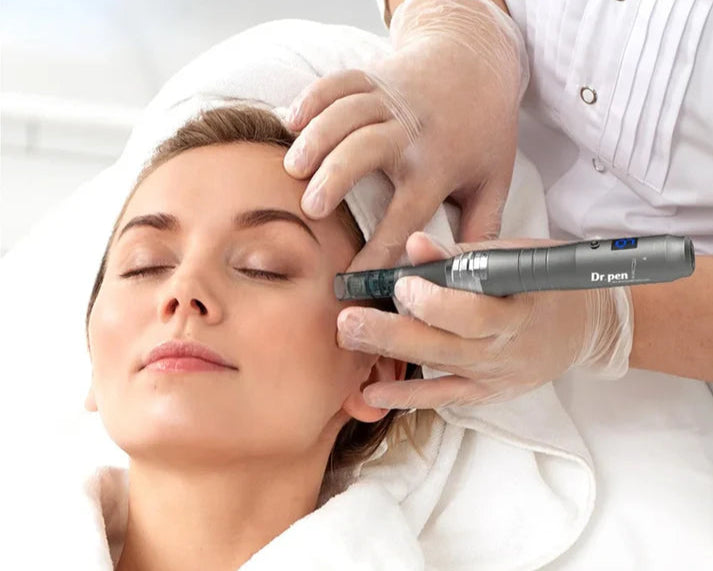Acne, a common skin condition that affects millions of people worldwide, can be a source of significant distress and self-esteem issues. From teenage years to adulthood, the quest for clear, smooth skin often leads individuals down various treatment paths, each promising different results. One such method that has gained popularity in recent years is the use of a microneedling pen. But can this innovative device truly help with acne, and what does the science say?

To understand the potential of microneedling pens in treating acne, it's essential to delve into what acne is and how it forms. Acne occurs when hair follicles become clogged with oil and dead skin cells, leading to the formation of pimples, blackheads, or whiteheads. This process is often exacerbated by hormones, particularly androgens, which stimulate the sebaceous glands to produce more sebum (oil). Bacteria on the skin can also play a role, as they can invade the clogged follicles and cause inflammation.
Traditional acne treatments range from over-the-counter topical creams and gels containing ingredients like benzoyl peroxide or salicylic acid to prescription medications such as antibiotics and retinoids. In more severe cases, oral isotretinoin (a form of vitamin A) may be prescribed. While these treatments can be effective, they often come with side effects, and not everyone responds to them in the same way. This has led to a growing interest in alternative or complementary therapies, including microneedling.
Microneedling, also known as collagen induction therapy, involves using a device equipped with tiny, fine needles to create controlled micro-injuries on the skin's surface. These micro-injuries stimulate the body's natural healing process, prompting it to produce more collagen and elastin. Collagen is a protein that gives skin its structure and elasticity, while elastin helps support the dermal structure.
A microneedling pen is a handheld device that makes this process more accessible and precise. It typically contains a cartridge with a series of fine needles that can be adjusted to different lengths depending on the treatment area and desired depth of penetration. When used correctly, a microneedling pen can create thousands of micro-channels in the skin within minutes, triggering the healing response without causing significant damage or scarring.
So, how does this relate to acne? The theory behind using a microneedling pen for acne is multifaceted. Firstly, the micro-injuries created by the needles can help to break up and disperse the clogged material within the hair follicles, potentially reducing the formation of pimples. Secondly, the increased collagen production can improve skin texture and reduce the appearance of acne scars. Lastly, the process may also enhance the absorption of topical acne treatments by creating pathways for the active ingredients to penetrate deeper into the skin.
Several studies have investigated the effectiveness of microneedling for various skin conditions, including acne scars. A study published in the Journal of Cosmetic Dermatology in 2018 found that microneedling therapy significantly improved the appearance of atrophic acne scars over a series of treatments. Another study, published in the Journal of Dermatological Treatment in 2016. reported similar findings, noting that microneedling was a safe and effective treatment option for acne scarring.
While these studies focused on acne scars rather than active acne, the principles behind microneedling's effectiveness suggest it could also benefit those with active breakouts. By promoting skin cell turnover and enhancing the skin's ability to heal itself, microneedling may help to reduce inflammation and clear up existing pimples more quickly. However, it's important to note that microneedling should not be used on active, inflamed acne lesions, as this could lead to further irritation and potential infection.
Before considering microneedling for acne, it's crucial to consult with a qualified dermatologist or skincare professional. They can assess your skin type, the severity of your acne, and any underlying medical conditions that could affect treatment. Microneedling is generally considered safe when performed by a trained professional, but like any medical procedure, it carries some risks. These include infection, skin irritation, and hyperpigmentation (darkening of the skin).
If you decide to proceed with microneedling, you can expect a series of treatments spaced several weeks apart. The number of sessions required will depend on your individual needs and goals. Prior to each treatment, your skin will be thoroughly cleaned, and a topical numbing cream may be applied to minimize discomfort. During the procedure, the microneedling pen will be gently glided over the skin, creating the micro-injuries. Afterward, your skin may be red and slightly swollen, similar to a mild sunburn, but this should subside within a few days.
In addition to professional microneedling treatments, there are also at-home microneedling devices available. While these can be more convenient and cost-effective, they come with a higher risk of complications if not used correctly. It's essential to follow the manufacturer's instructions carefully and avoid over-treating the skin, as this can lead to damage.
To enhance the results of microneedling for acne, it's often combined with other treatments. For example, using a topical acne medication or a skin-care regimen tailored to your skin type can help to address the underlying causes of acne while the microneedling works to improve skin texture and reduce scarring.
In conclusion, while more research is needed to fully understand the extent of microneedling's effectiveness for active acne, the available evidence suggests it can be a beneficial adjunct therapy, particularly for improving acne scars and overall skin texture. When used appropriately and under the guidance of a qualified professional, microneedling pens can offer a safe and effective way to enhance the skin's natural healing process and promote a clearer, more radiant complexion. As always, it's essential to approach any skin treatment with caution, do your research, and consult with a healthcare provider to determine the best course of action for your individual needs.

Share:
How to Choose a Microneedling Pen for Professional Use
How to Prepare Your Skin for a Microneedling Pen Treatment